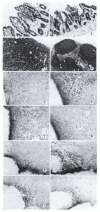Evidences for vagus nerve in maintenance of immune balance and transmission of immune information from gut to brain in STM-infected rats
- PMID: 12046088
- PMCID: PMC4656439
- DOI: 10.3748/wjg.v8.i3.540
Evidences for vagus nerve in maintenance of immune balance and transmission of immune information from gut to brain in STM-infected rats
Abstract
Aim: To determine whether Salmonella Typhimurium (STM)in gastrointestinal tract can induce the functional activation of brain, whether the vagus nerve involves in signaling immune information from gastrointestinal tract to brain and how it influences the immune function under natural infection condition.
Methods: Animal model of gastrointestinal tract infection in the rat was established by an intubation of Salmonella Typhimurium (STM) into stomach to mimic the condition of natural bacteria infection. Subdiagphragmatic vagotomy was performed in some of the animals 28 days before infection. The changes of Fos expression visualized with immunohistochemistry technique in hypothalamic paraventricular nucleus (PVN) and superaoptic nucleus (SON) were counted. Meanwhile, the percentage and the Mean Intensities of Fluorescent (MIFs) of CD4+ and CD8+ T cells in peripheral blood were measured by using flow cytometry (FCM), and the pathological changes in ileum and mesenteric lymph node were observed in HE stained sections.
Results: In bacteria-stimulated groups, inflammatory pathological changes were seen in ileum and mesenteric lymph node. The percentages of CD4+ T cells in peripheral blood were decreased from 42%+/-4.5% to 34%+/-4.9% (P<0.05) and MIFs of CD8+ T cells were also decreased from 2.9+/-0.39 to 2.1+/-0.36 (P<0.05) with STM stimulation. All of them proved that our STM-infection model was reliable. Fos immunoreactive (Fos-ir) cells in PVN and SON increased significantly with STM stimulation, from 189+/-41 to 467+/-62 (P<0.05) and from 64+/-21 to 282+/-47 (P<0.05) individually, which suggested that STM in gastrointestinal tract induced the functional activation of brain. Subdiagphragmatic vagotomy attenuated Fos expression in PVN and SON induced by STM, from 467+/-62 to 226+/-45 (P<0.05) and from 282+/-47 to 71+/-19 (P<0.05) individually, and restored the decreased percentages of CD4+ T cells induced by STM from 34%+/-4.9% to original level 44%+/-6.0% (P<0.05). In addition, subdiagphragmatic vagotomy itself also decreased the percentages of CD8+ T cells (from 28%+/-3.0% to 21%+/-5.9%, P<0.05) and MIFs of CD4+ (from 6.6+/-0.6 to 4.9+/-1.0, P<0.05) and CD8+ T cells (from 2.9+/-0.39 to 1.4+/-0.34, P<0.05). Both of them manifested the important role of vagus nerve in transmitting immune information from gut to brain and maintaining the immune balance of the organism.
Conclusion: Vagus nerve does involve in transmitting abdominal immune information into the brain in STM infection condition and play an important role in maintenance of the immune balance of the organism.
Figures


Similar articles
-
Alleviating effect of vagus nerve cutting in Salmonella-induced gut infections and anxiety-like behavior via enhancing microbiota-derived GABA.Brain Behav Immun. 2024 Jul;119:607-620. doi: 10.1016/j.bbi.2024.04.034. Epub 2024 Apr 23. Brain Behav Immun. 2024. PMID: 38663772
-
Characterization of CD4+ subpopulations and CD25+ cells in ileal lymphatic tissue of weaned piglets infected with Salmonella Typhimurium with or without Enterococus faecium feeding.Vet Immunol Immunopathol. 2014 Apr 15;158(3-4):143-55. doi: 10.1016/j.vetimm.2014.01.001. Epub 2014 Jan 8. Vet Immunol Immunopathol. 2014. PMID: 24485092
-
Gastric distension-induced release of 5-HT stimulates c-fos expression in specific brain nuclei via 5-HT3 receptors in conscious rats.Am J Physiol Gastrointest Liver Physiol. 2004 Jul;287(1):G228-35. doi: 10.1152/ajpgi.00373.2003. Epub 2003 Dec 18. Am J Physiol Gastrointest Liver Physiol. 2004. PMID: 14684379
-
Vagus-brain communication in atherosclerosis-related inflammation: a neuroimmunomodulation perspective of CAD.Atherosclerosis. 2007 Dec;195(2):e1-9. doi: 10.1016/j.atherosclerosis.2006.10.009. Epub 2006 Nov 13. Atherosclerosis. 2007. PMID: 17101139 Review.
-
Vagus Nerve Stimulation at the Interface of Brain-Gut Interactions.Cold Spring Harb Perspect Med. 2019 Aug 1;9(8):a034199. doi: 10.1101/cshperspect.a034199. Cold Spring Harb Perspect Med. 2019. PMID: 30201788 Free PMC article. Review.
Cited by
-
Intestinal microbiota as modulators of the immune system and neuroimmune system: impact on the host health and homeostasis.J Immunol Res. 2015;2015:931574. doi: 10.1155/2015/931574. Epub 2015 Feb 22. J Immunol Res. 2015. PMID: 25759850 Free PMC article. Review.
-
Levels of vasoactive intestinal peptide, cholecystokinin and calcitonin gene-related peptide in plasma and jejunum of rats following traumatic brain injury and underlying significance in gastrointestinal dysfunction.World J Gastroenterol. 2004 Mar 15;10(6):875-80. doi: 10.3748/wjg.v10.i6.875. World J Gastroenterol. 2004. PMID: 15040036 Free PMC article.
-
Microbial Reprogramming in Obsessive-Compulsive Disorders: A Review of Gut-Brain Communication and Emerging Evidence.Int J Mol Sci. 2023 Jul 26;24(15):11978. doi: 10.3390/ijms241511978. Int J Mol Sci. 2023. PMID: 37569349 Free PMC article. Review.
-
Human leukemia antigen-A*0201-restricted epitopes of human endogenous retrovirus W family envelope (HERV-W env) induce strong cytotoxic T lymphocyte responses.Virol Sin. 2017 Aug;32(4):280-289. doi: 10.1007/s12250-017-3984-9. Epub 2017 Aug 22. Virol Sin. 2017. PMID: 28840564 Free PMC article.
-
Microbiome-microglia connections via the gut-brain axis.J Exp Med. 2019 Jan 7;216(1):41-59. doi: 10.1084/jem.20180794. Epub 2018 Nov 1. J Exp Med. 2019. PMID: 30385457 Free PMC article. Review.
References
-
- Maier SF, Goehler LE, Fleshner M, Watkins LR. The role of the vagus nerve in cytokine-to-brain communication. Ann N Y Acad Sci. 1998;840:289–300. - PubMed
-
- Goehler LE, Gaykema RP, Hansen MK, Anderson K, Maier SF, Watkins LR. Vagal immune-to-brain communication: a visceral chemosensory pathway. Auton Neurosci. 2000;85:49–59. - PubMed
-
- Dantzer R, Konsman JP, Bluthé RM, Kelley KW. Neural and humoral pathways of communication from the immune system to the brain: parallel or convergent? Auton Neurosci. 2000;85:60–65. - PubMed
-
- Watkins LR, Maier SF, Goehler LE. Cytokine-to-brain communication: a review & amp; analysis of alternative mechanisms. Life Sci. 1995;57:1011–1026. - PubMed
-
- Wang X, Wang BR, Ju G. The role of the vagus nerve in transmitting immune information into the brain. Shanghai Mianyixue Zazhi. 2000;20:192–194.
Publication types
MeSH terms
LinkOut - more resources
Full Text Sources
Other Literature Sources
Research Materials

